I absolutely love making cinnamon rolls and have made a bunch of flavors over the years. But somehow, I’ve never made mini cinnamon rolls!
And I think we can all agree that miniature treats always taste better!!

These little cinnies are made from scratch and bake up soft, fluffy and perfectly bitesized. They’re equally adorable & delicious!
To make sure your mini cinnies bake up perfectly, I’ve shared a few notes about this recipe below.
Making These Mini Cinnamon Rolls by Hand vs. Stand Mixer
This recipe can be made by hand or with a dough hook / stand mixer.
I recommend making it by hand because it’s such a small portion of dough! A stand mixer might struggle to properly mix everything together, especially if you have a large stand mixer.

Whichever method you use to make the dough, just be sure to knead or mix the dough until it gets an elastic texture and pulls away from the bowl or counter.
Once you get to this point, stop and let the dough rest for about 10 minutes. This little break allows the gluten to relax bit and makes the dough easier to roll out.

If you continue to work the dough, the gluten strands can become too tight. Just like adding in too much flour, this can also lead to dense cinnamon rolls.
It’s pretty easy to sense when the dough is ready if you’re kneading by hand.
However, if you’re using a stand mixer keep a close eye on your dough to ensure you don’t accidentally overwork it.
How Much Flour Am I Supposed to Use??
One part of this recipe that can be a bit daunting or hard to interpret is the amount of flour this recipe uses. As you can see on the recipe card, it isn’t a set amount.
I tried so hard to find the perfect amount, but the truth is it will vary batch to batch, and kitchen to kitchen.
I’ve made these by hand and in a stand mixer. Each time I use a slightly different amount of flour.
Now, the amount of flour you start with is set at 1 2/3 cups of all-purpose flour.
But as you add in your wet ingredients and the egg, a sticky dough ball forms and you will need to add in additional flour.

I add in 1 tablespoon of flour at a time as I knead the dough. You need to add enough flour to create an elastic, workable dough that you can roll out.
However, if you add too much flour you can end up with dense, chewy cinnamon rolls.
This is why it’s a range. When using my stand mixer, I usually add in about 1-3 additional tablespoons of flour. In some batches I’ve used less and in a few I’ve used more.
Making These Mini Cinnamon Rolls the Perfect Size
What makes these mini cinnies so cute is their size! With that in mind, it’s important that you roll the dough out to the right size and cut equal-sized pieces.
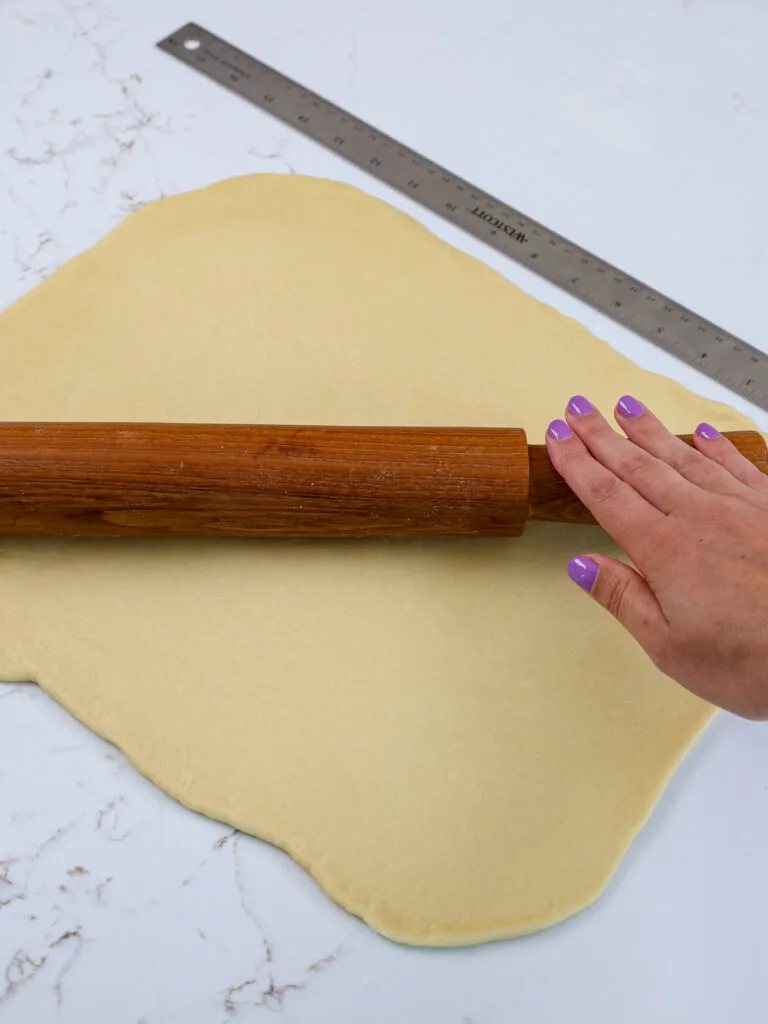
I get really crazy about it and like to use a ruler to make sure I get the dimensions right. It also helps me cut each cinnamon roll to be the exact same size.
After all, I didn’t go to the effort of making homemade cinnamon rolls just to cut them different sizes and have them bake up unevenly!
To make perfect mini cinnamon rolls, I cut 16 cinnamon rolls from the rolled dough.

I love making them this size because it means you can go back for seconds or serve these as a side at a big brunch.
And if you remove them from the pan as a sheet, they basically become pull apart cinnamon rolls!
The Secret to Fluffy Mini Cinnamon Rolls: An Assisted Rise
Another thing that helps these mini cinnamon rolls turn out soft and fluffy is an assisted rise.
This recipe uses your oven to help the yeast rise. Don’t worry, the oven is preheated at a low temperature (200 F/ 95 C) and then turned off before you place the cinnamon rolls in there to rise.
Below is a picture of these mini cinnamon rolls before popping them into the oven to rise.

The cinnamon roll pan is also covered with foil to ensure no actual baking takes place.
I love this method because in the winter my house is always cold. It’s almost impossible to find a warm spot for the cinnamon rolls to rise.
No matter what temperature your kitchen is, your cinnamon rolls are guaranteed to rise and puff up with this method.
You also know how long it will take for them to rise (about 30 minutes), rather than anxiously checking on them every 10 minutes to see if they’ve risen.
The Best Way to Cut Cinnamon Rolls: Dental Floss
This might sound odd, but I highly recommend having some floss on hand to help cut your cinnamon rolls.
Most knives don’t cut the rolls as cleanly and tend to kind of smush the cinnamon roll log.
However, if you use a piece of floss, it cuts through the dough smoothly. It takes hardly any effort, and you get perfectly cut cinnamon rolls every time!

This is extra helpful when you’re cutting a bunch of mini cinnamon rolls. Try it just once and you’ll never look back.
And if you only have mint dental floss on hand? Don’t worry! I tried this with mint flavored dental floss, and my husband had no clue. I also couldn’t tell 🙂
The Best Mini Cinnamon Roll Icing
The finishing touch on any cinnamon roll has to be the cream cheese icing.
A cinnamon roll isn’t complete without its topping. While I was tempted to top these with my cream cheese buttercream, I decided to create a delicious cream cheese glaze.
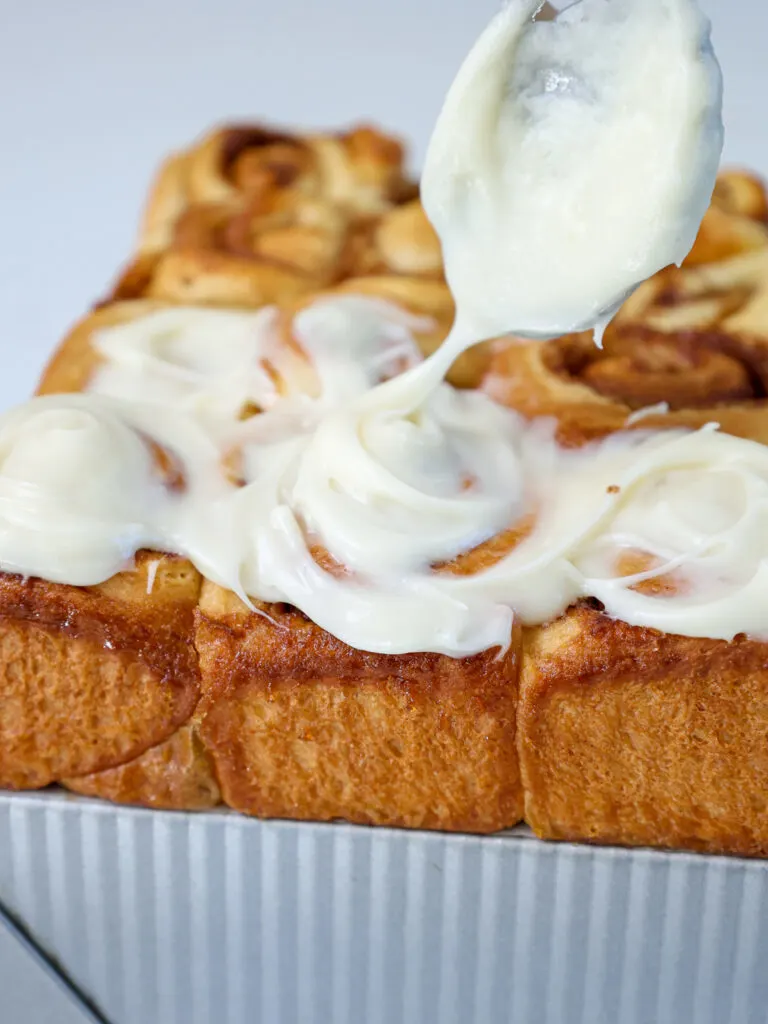
I found that a glaze with a 2:1 ratio of cream cheese to butter helped the cream cheese flavor shine through.
In addition to packing this glaze with flavor, it’s also important to get the consistency right.
You want the glaze to be thick enough to spoon onto each cinnamon roll, but thin enough that it will melt over every inch of your cinnamon rolls.
This mini cinnamon roll icing uses powdered sugar to make it nice and sweet, then it’s thinned out with some heavy cream and vanilla extract.

Substitutions and Swaps in This Recipe
While I love this recipe just the way it is, I know you might not have all these ingredients on hand!
Below are some swaps and substitutions that can be made in this recipe.
- All Purpose Flour – I haven’t tested this recipe out with gluten free flour, but it should work if you use a good blend like King Arthur’s GF flour. Just be sure to knead the dough a bit longer to help give it structure.
- Instant / Rapid Rise Yeast – You can use active dry yeast in place of the instant yeast in this recipe, just be sure to activate the yeast with warm water and sugar before adding it and allow the dough to rise for a bit longer (active yeast takes longer to rise than instant).
- Unsalted Butter – If you only have salted butter on hand, you can use it in place of the unsalted butter in this recipe. Just be sure to omit the salt that this recipe calls for. You can also use vegan butter in its place!
- Whole Milk – Most alternative milks work fine in this recipe, including soy, oat, and almond milk.
- Granulated Sugar – I don’t recommend changing the type or amount of sugar used in the dough.
- Large Egg – This is an enriched dough, so it uses an egg. For best results large, room temperature eggs.
- Brown Sugar – You can use light or dark brown sugar to make the filling for these cinnamon rolls. I prefer using light in this recipe!
Tips for Making the Best Mini Homemade Cinnamon Rolls
- Don’t add too much flour! Add in additional flour 1 Tbsp at a time and check the dough using the finger test. When you poke the dough with your finger, it should feel tacky but not sticky. As you pull your finger away, there should be no residue on your finger.
- Use a ruler to make sure your dough is rolled out to the right size (16 x 6-in) and cut into 16 even pieces. They should each be about 1 inch tall.
- Use dental floss to easily cut each cinnamon roll rather than a knife.
- Bake the cinnamon rolls in a greased square pan (mine is 8 in x 8 in) for best results.
- Try to let the cinnamon rolls cool for about 10-20 minutes, then add the glaze. This will allow it to perfectly melt over your cinnamon rolls!
- Store leftover cinnamon rolls or cinnamon rolls made ahead of time in an airtight container to keep them fresh.
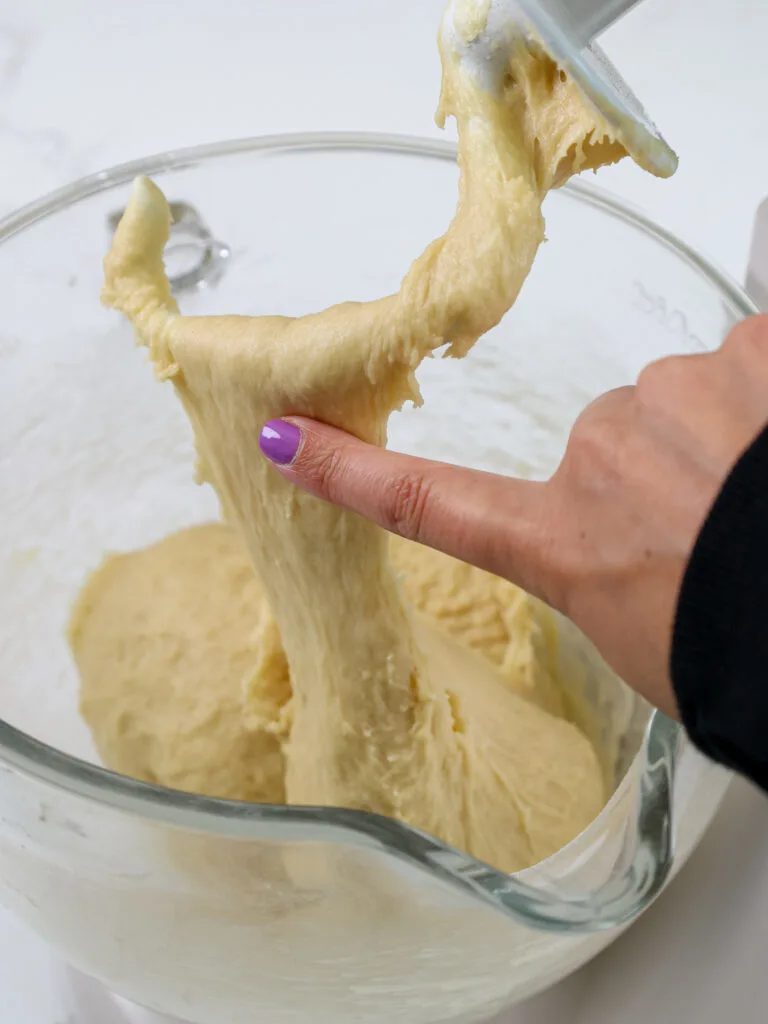
Making These Mini Cinnamon Rolls in Advance
If you want to make these mini cinnamon rolls ahead of time, be my guest! I’m all about working ahead and making life easier.
This recipe can be made the evening before and then baked the following morning.
You can refrigerate these cinnamon rolls after they have been cut in a greased or lined pan.
Cover the cinnamon roll pan tightly with plastic wrap, making sure the seal is airtight.
If the cinnamon rolls are exposed to air, they can dry out and no one wants dry cinnamon rolls!
The morning you want to bake them, take them out 1 hour before you plan to bake them to let them rise, then follow the recipe instructions to bake.

You can also bake the cinnamon rolls, then let them cool and freeze them individually.
This is what I do with our leftover cinnamon rolls. I leave the leftover rolls unfrosted, then tightly wrap each roll in a layer of plastic wrap then foil.
I move individual cinnamon rolls from the freezer to the fridge the night before I want to eat them.
Then in the morning, I unwrap the cinnamon roll and heat it up in the microwave until it’s warm and gooey. This usually takes about 10 seconds in my microwave.
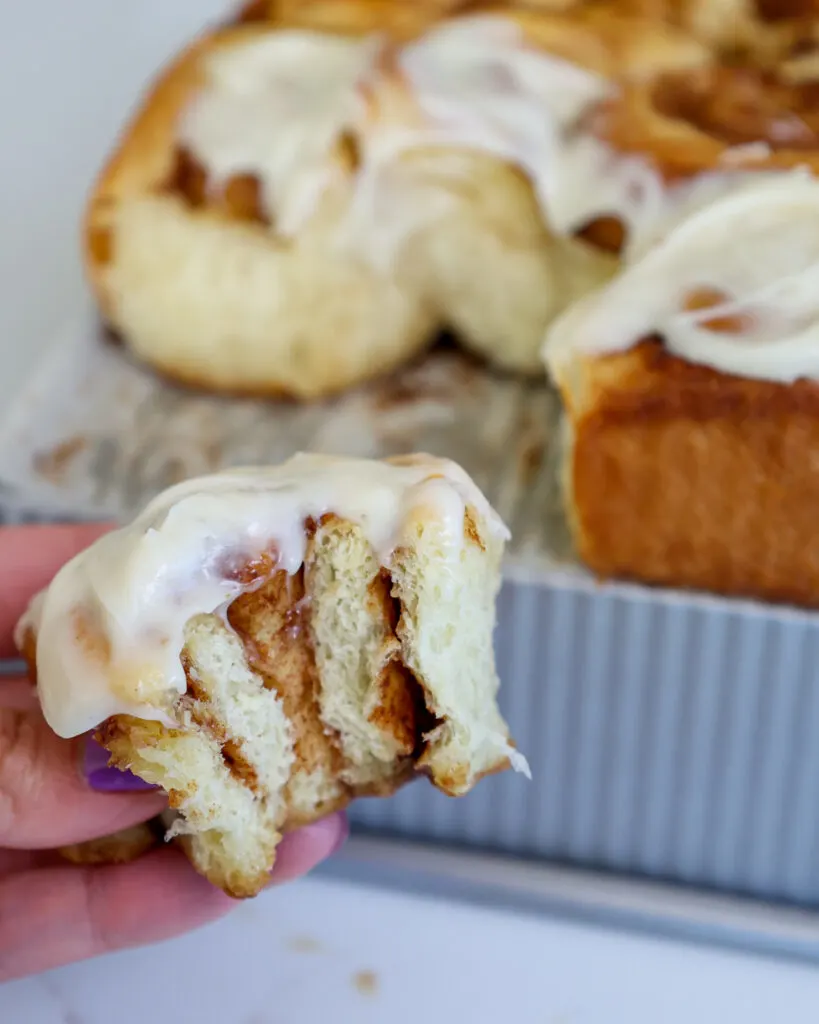
Let Me Know What You Think
If you try this recipe for mini cinnamon rolls, I’d love to hear what you think! Please leave a rating and comment below.
You can also tag me on social media @chelsweets or use #chelsweets so I can see everything you’re baking up!!
Other Recipes You Might Like:

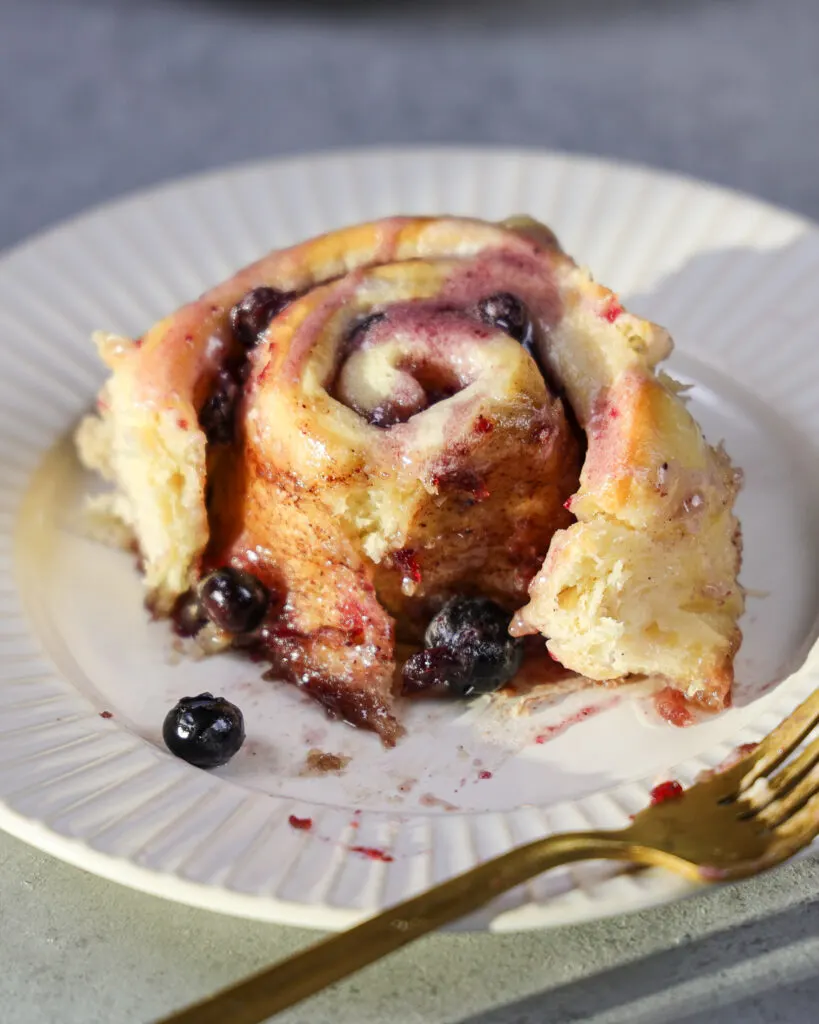
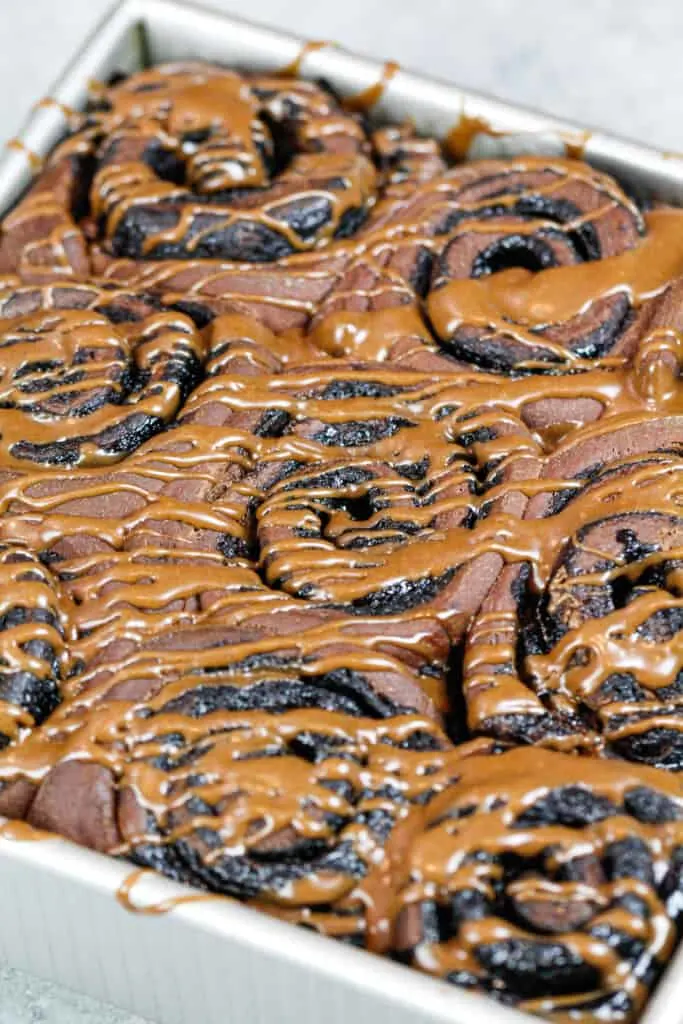

Mini Cinnamon Rolls

These mini cinnamon rolls are made from scratch and bake up soft, fluffy, and perfectly bitesized! They're adorable & delicious!!
Ingredients
Cinnamon Roll Filling
- 1/3 cup packed light brown sugar (66g)
- 1 1/2 tsp ground cinnamon (3g)
- 3 Tbsp unsalted butter, room temperature (45g)
Mini Cinnamon Roll Dough
- 2 cups all-purpose flour + about 2 Tbsp (250-280g)
- 2 1/4 tsp or 1 packet instant dry yeast (7g, 1/4 oz.)
- 1/2 tsp fine salt (3g)
- 1/2 cup whole milk (120g)
- 1/4 cup unsalted butter (56g)
- 1/4 cup sugar (50g)
- 1 large egg, room temperature (56g)
Mini Cinnamon Roll Glaze
- 1/4 cup cream cheese, room temperature (56g)
- 2 Tbsp unsalted butter, room temperature (28g)
- 1 tsp vanilla extract (4g)
- 1 cup powdered sugar (125g)
- 1 Tbsp whole milk (15g)
Instructions
Mini Cinnamon Roll Filling
- In a medium-sized bowl, mix 1/3 cup packed brown sugar and 1 1/2 tsp cinnamon together. Cover and set aside.
Mini Cinnamon Roll Dough
- This recipe can be made in a stand mixer or by hand. I recommend making it by hand because it's such a small portion of dough! A stand mixer might struggle to properly mix everything together, especially if you have a large stand mixer.
- In a large bowl or the bowl of a stand mixer, whisk together 2 cups of flour, 1 packet of instant dry yeast and 1/2 tsp salt.
- In a separate bowl, combine 1/2 cup milk, 1/4 cup softened butter and 1/4 cup granulated sugar. Heat for 45 seconds in the microwave and stir to combine the ingredients. The butter should be fully melted, and the liquid should be warm to the touch but not hot. If it's too hot, it will kill the yeast!
- Slowly pour the warm milk mixture into the flour mixture and mix on medium speed with a dough hook or by hand. Scrape around the edges with a rubber spatula to make sure all the flour gets incorporated. Mix until fully combined.
- Add in 1 large egg. Mix together until a sticky dough ball forms. If you're using a stand mixer, you may need to stir the egg and the dough together with a dough whisk or spoon during this stage.
- Mix the dough for another 5 minutes by hand, or mix the dough on a medium-low speed for 2-3 minutes with a mixer. The dough should become elastic and smooth.
- Keep mixing the dough and add additional flour 1 Tbsp at a time until the dough is tacky but no longer sticky (usually takes me anywhere from 1-3 additional Tbsp of flour). It should pull away / no longer stick to the sides of your mixing bowl once it's ready to rest. I like to poke the dough with my finger and see if it leaves any residue. If it's still super sticky, keep adding in additional flour. If it feels tacky but doesn't leave any residue on your finger, it's ready to go!
- Cover your bowl with plastic wrap and set aside to allow the dough to rest for 10-20 minutes to allow the gluten to relax. This will make it easier to roll out.
- Place the dough on a lightly floured surface and roll it into a large rectangle that's about 16 in x 8 in. It should be about 1/2 cm thick.
- Spread 3 Tbsp of room temperature butter on the dough, leaving 1/4 inch of dough on the long side of the rectangle uncovered (this will help you seal off the roll and keep it tight). Spread the filling over the buttered section of the dough in an even layer. Dip your finger in a little bit of water and run it along the uncovered strip.
- Roll the dough horizontally, toward the uncovered strip. Cut 16 equal pieces using dental floss. It sounds weird but it gives you super clean cuts! Each cinnamon roll should be 1 inch tall. Place the mini cinnamon rolls in either a greased 8 in x 8 in pan or in a mini cupcake pan.
- If you are making these cinnamon rolls the night before, cover the cinnamon rolls tightly with plastic wrap and place in the fridge overnight.
- If you make these the morning of, proof them in a warm place for about 20 minutes. I like to preheat my oven to 200 F, turn it off, then place my cinnamon rolls into the oven to proof because my apartment is always cold.
- If you make these cinnamon rolls the night before, take them out of the fridge an hour before you want to bake them. Place the rolls in a warm place to thaw and proof.
- Once they have risen, preheat your oven to 350 F / 175 C. If you make these in an 8- x 8-inch pan, bake them for 23-26 minutes. If you bake these in a mini muffin tin, bake them for 18-22 minutes or until rolls are golden brown. Rotate the pan halfway through to help them bake evenly.
Cream Cheese Cinnamon Roll Frosting
- To make the frosting, mix 1/4 cup of cream cheese, 2 Tbsp of unsalted butter, 1 tsp vanilla extract, 1 cup of powdered sugar, and 1 Tbsp of whole milk together with a whisk or hand mixer. Mix until smooth.
- Let the cinnamon rolls cool for about 10-20 minutes, then spoon frosting over the cinnamon rolls and enjoy them warm.
Notes
Using the Right Type of Yeast: Active vs. Instant Yeast
Make sure you're using instant yeast! It comes in small packets that can usually be found in the refrigerated section of your grocery store.
You can use active dry yeast in place of the instant yeast in this recipe, just be sure to activate it in a small bowl with 2 Tbsp of warm water and 1 tsp sugar before adding it into the dough and allow the dough to rise for longer (active yeast takes longer to rise than instant).
Tips for Making the Best Cinnamon Rolls
- Use a ruler to make sure your dough is rolled out to the right size (16 x 8-in) and cut into even pieces.
- Use dental floss to easily cut each cinnamon roll rather than a knife.
- If you're struggling to cut your cinnamon rolls, place the cinnamon roll log on a baking sheet and chill it in the fridge for 20-30 minutes. It will make it easier to cut.
- Cut equally sized cinnamon rolls from your log to make sure they all bake evenly.
- Try to let the cinnamon rolls cool for about 10-20 minutes, then add the frosting. This will allow it to perfectly melt over your cinnamon rolls!
Making these Cinnamon Rolls in Advance
This recipe can be made the evening before and baked the following morning.
You can refrigerate these cinnamon rolls after they have been cut in a greased or lined pan. Cover the cinnamon roll pan tightly with plastic wrap, making sure the seal is airtight.
The morning you want to bake them, take them out an hour before you plan to bake them to let them warm up and rise a bit. Then follow the recipe instructions to bake in step 15.
Nutrition Information
Yield
16Serving Size
1Amount Per Serving Calories 139Total Fat 8gSaturated Fat 5gTrans Fat 0gUnsaturated Fat 3gCholesterol 33mgSodium 95mgCarbohydrates 15gFiber 0gSugar 14gProtein 1g
